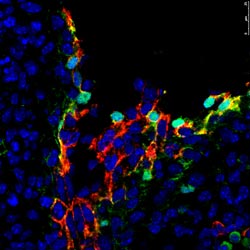Key function of protein discovered for obtaining blood stem cells as source for transplants

Detail of the aorta of a 10.5 days mouse embryo where we can see in green the cells with activated b-catenin. Some of these cells will be in the future hematopoietic stem cells.<br>
Researchers from IMIM (Hospital del Mar Medical Research Institute) have deciphered the function executed by a protein called ¦Â-catenin in generating blood tissue stem cells.
These cells, also called haematopoietic, are used as a source for transplants that form part of the therapies to fight different types of leukaemia. The results obtained will open the doors to produce these stem cells in the laboratory and, thus, improve the quality and quantity of these surgical procedures. This will let patients with no compatible donors be able to benefit from this discovery in the future.
The study, executed jointly with the Erasmus Medical Center Stem Cell of Rotterdam and published in the Journal of Experimental Medicine, analysed a chain of molecular reactions that are produced inside some embryonic cells and that play a role in the creation of a haematopoietic stem cells. ¡®Our study contributes to deciphering the code that makes a precursor cell that is only found in the embryo become a haematopoietic stem cell. In order for that to happen, the ¦Â-catenin protein must be activated for a while and with a specific dosage¡¯ explains Dr Anna Bigas, head of the IMIM Stem Cells & Cancer Group and lead researcher.
This protein also plays a fundamental role in the cells that originate and maintain some types of leukaemia. ¡®The parallelisms between normal and leukaemia stem cells prove to us that the molecular pathways that regulate both populations are the same. For this reason, our work will help us understand the origin of these diseases¡¯, argues Dr Bigas.
In addition to embryonic stem cells, each of our body¡¯s organs has another type of stem cell that has the capacity to regenerate all the cells for the tissue in question. However, they are only formed in the embryonic stage and are maintained for the rest of our lives. Haematopoietic stem cells are part of the blood and, when they are transplanted, they are the inception for all of this tissue¡¯s cells.
At present, transplanting these cells is dependent on the availability of compatible donors. Nonetheless, there is still a high percentage of patients with no donors and that, therefore, cannot be submitted to this procedure. The results of this article lay the foundations so that, in the future, these patients can benefit from a source of laboratory-generated haematopoietic stem cells created from compatible embryonic cells or other types of expressly transformed cells.
Article of reference:
¡°Hematopoietic stem cell development requires transient Wnt/ ¦Â-catenin activity¡± Cristina Ruiz-Herguido, Jordi Guiu, Teresa D¡¯Altri , Julia Ingl¨¦s-Esteve, Elaine Dzierzak, Lluis Espinosa and Anna Bigas Journal of Experimental Medicine 10.1084/jem.20120225
Media Contact
More Information:
http://www.imim.esAll latest news from the category: Life Sciences and Chemistry
Articles and reports from the Life Sciences and chemistry area deal with applied and basic research into modern biology, chemistry and human medicine.
Valuable information can be found on a range of life sciences fields including bacteriology, biochemistry, bionics, bioinformatics, biophysics, biotechnology, genetics, geobotany, human biology, marine biology, microbiology, molecular biology, cellular biology, zoology, bioinorganic chemistry, microchemistry and environmental chemistry.
Newest articles

Superradiant atoms could push the boundaries of how precisely time can be measured
Superradiant atoms can help us measure time more precisely than ever. In a new study, researchers from the University of Copenhagen present a new method for measuring the time interval,…

Ion thermoelectric conversion devices for near room temperature
The electrode sheet of the thermoelectric device consists of ionic hydrogel, which is sandwiched between the electrodes to form, and the Prussian blue on the electrode undergoes a redox reaction…

Zap Energy achieves 37-million-degree temperatures in a compact device
New publication reports record electron temperatures for a small-scale, sheared-flow-stabilized Z-pinch fusion device. In the nine decades since humans first produced fusion reactions, only a few fusion technologies have demonstrated…





















